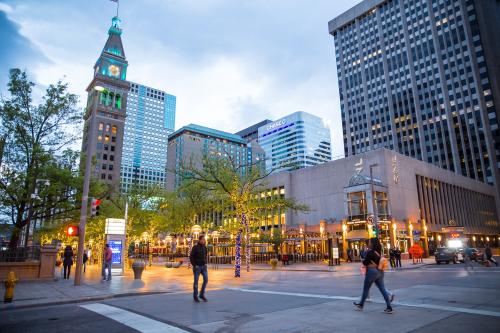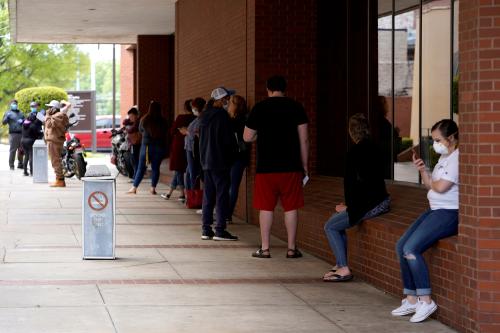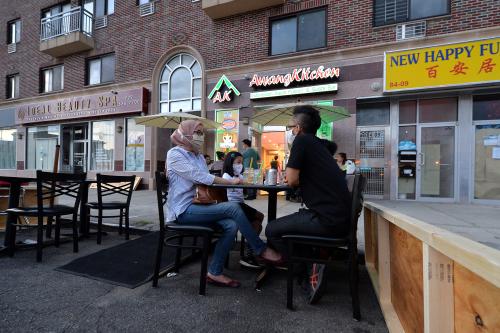Summer has not stopped COVID-19’s spread across the country, especially into states that had avoided the pandemic’s early impacts. As the virus and efforts to slow its spread batter more and more metropolitan economies, the timeline for widespread economic recovery grows increasingly uncertain. The latest data in our Metro Recovery Index illustrates that uncertainty in the nation’s Sun Belt, where a surge in COVID-19 cases has stalled the region’s fragile recovery.
The Sun Belt initially weathered labor market downturns better than other places
In the first weeks of the country’s pandemic-induced economic shutdowns (through mid-March), job losses were largely concentrated among very large metro areas in the West and the Northeast Corridor. These were the initial places where COVID-19 cases spread most rapidly and where government-ordered shutdowns first took effect.
This trend continued into mid-June, as lower numbers of COVID-19 cases and shorter shutdown periods yielded stronger labor market indicators in Sun Belt metro areas. While unemployment rates increased in practically every metro area from June 2019 to June 2020, Sun Belt cities experienced significantly smaller increases. Exceptions to this were large tourism hubs such as Las Vegas and Orlando, Fla., as well as metro areas in California, which locked down more stringently than most other Sun Belt states. Meanwhile, New York, Boston, and Detroit continued to see double-digit unemployment rate increases.
July job postings data show the Sun Belt faltering
By late June, however, there was a considerable shift in the geography of the COVID-19 pandemic and its economic impact. While all 50 states had begun to reopen to some degree in May, the greatest increases in COVID-19 cases over the early-to-midsummer period emerged in the states that reopened quickest. Starting in June and continuing into July, the Sun Belt experienced a surge in cases, leading mayors and governors to scale back their reopening plans.
While July data on jobs and unemployment for metro areas will not be available for a few more weeks, job postings data from Emsi provides some clues into the month’s shifting patterns of economic strength and weakness. According to the data, in July, job postings increased from their June levels in nearly every U.S. metro area, but increases in Sun Belt cities tended to be smaller. This could reflect the region’s earlier reopenings, with job postings not increasing as much in July because they had already risen in May and June. However, year-over-year declines from July 2019 to July 2020 were also more pronounced in Sun Belt metro areas, signaling a significant slowdown in recent hiring activity.
As COVID-19 spread, visits to workplaces stalled across the Sun Belt
After bouncing back in May and June, travel to places of work declined almost across the board in July, affecting 186 out of the 192 metro areas included in the analysis. Mobility data from Google reveals that these decreases were concentrated in Sun Belt metro areas, particularly in states that were reversing reopening efforts after experiencing COVID-19 spikes in June and July (e.g., Texas, Florida, Arizona, and California). This suggests that Sun Belt residents and their employers are increasingly heeding calls to shelter in place and work from home where possible.

By contrast, metro areas in states that reopened more slowly have seen a different trajectory. In Boston, Detroit, New York, and Philadelphia, July brought both declining COVID-19 caseloads and either small increases or only modest declines in workplace visits.
Small business recovery comes to a halt across the country
Through April, about 40% of U.S. small businesses had shuttered due to the pandemic. The drop was even more dramatic in metro areas with early, large COVID-19 outbreaks, in states such as New York, New Jersey, Massachusetts, Michigan, and Illinois. Sun Belt metro areas experienced somewhat fewer small business closures during this time. As states lifted lockdown orders in May and June, the share of businesses reopening in very large metro areas across the country steadily increased.
In July, however, very large metro areas in the Sun Belt diverged from their Northeastern and Midwestern counterparts. While the share of open businesses in Boston, Chicago, Detroit, and New York continued to rise, the share declined in Atlanta, Birmingham, Ala., Houston, Memphis, Tenn., and Tampa, Fla. This likely reflected the reversal of prior reopenings in Sun Belt states and rising consumer wariness as COVID-19 cases there began to spike.

Each of these findings reinforces that the path of COVID-19 and the trajectory of the economy remain inextricably linked. As COVID-19 cases have spiked across Sun Belt metro areas in recent weeks, hopes for a quick economic recovery in those regions have dissipated, even as metro areas that the pandemic hit harder and earlier continue to rebound.










Commentary
The Sun Belt’s COVID-19 surge stalls economic recovery in the region
August 14, 2020